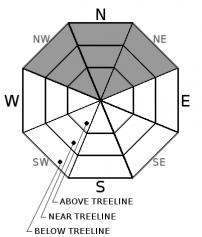| Friday | Friday Night | Saturday | |
|---|---|---|---|
| Weather: | Partly cloudy skies. | Partly cloudy skies. | Partly cloudy skies. |
| Temperatures: | 53 to 58 deg. F. | 29 to 34 deg. F. | 50 to 55 deg. F. |
| Mid Slope Winds: | SW | SW | SW |
| Wind Speed: | 10 to 15 mph with gusts to 25 mph, increasing to 15 to 25 mph with gusts to 40 mph in the afternoon. | 15 to 20 mph with gusts to 40 mph. | 10 to 20 mph with gusts to 35 mph. |
| Expected snowfall: | 0 | 0 | 0 |
| Friday | Friday Night | Saturday | |
|---|---|---|---|
| Weather: | Partly cloudy skies. | Partly cloudy skies. | Partly cloudy skies. |
| Temperatures: | 49 to 55 deg. F. | 30 to 35 deg. F. | 47 to 53 deg. F. |
| Ridge Top Winds: | SW | SW | SW |
| Wind Speed: | 20 to 35 mph. Gusts to 45 mph increasing to 70 mph in the afternoon. | 20 to 30 mph. Gusts to 70 mph decreasing to 60 mph after midnight. | 20 to 30 mph with gusts to 50 mph. |
| Expected snowfall: | 0 | 0 | 0 |
























